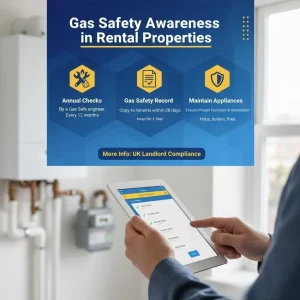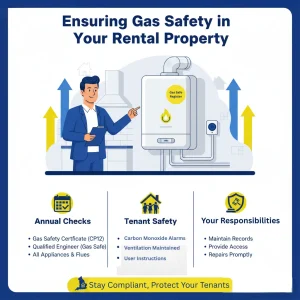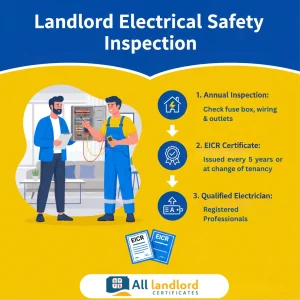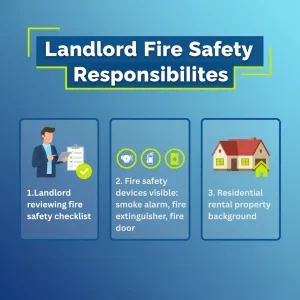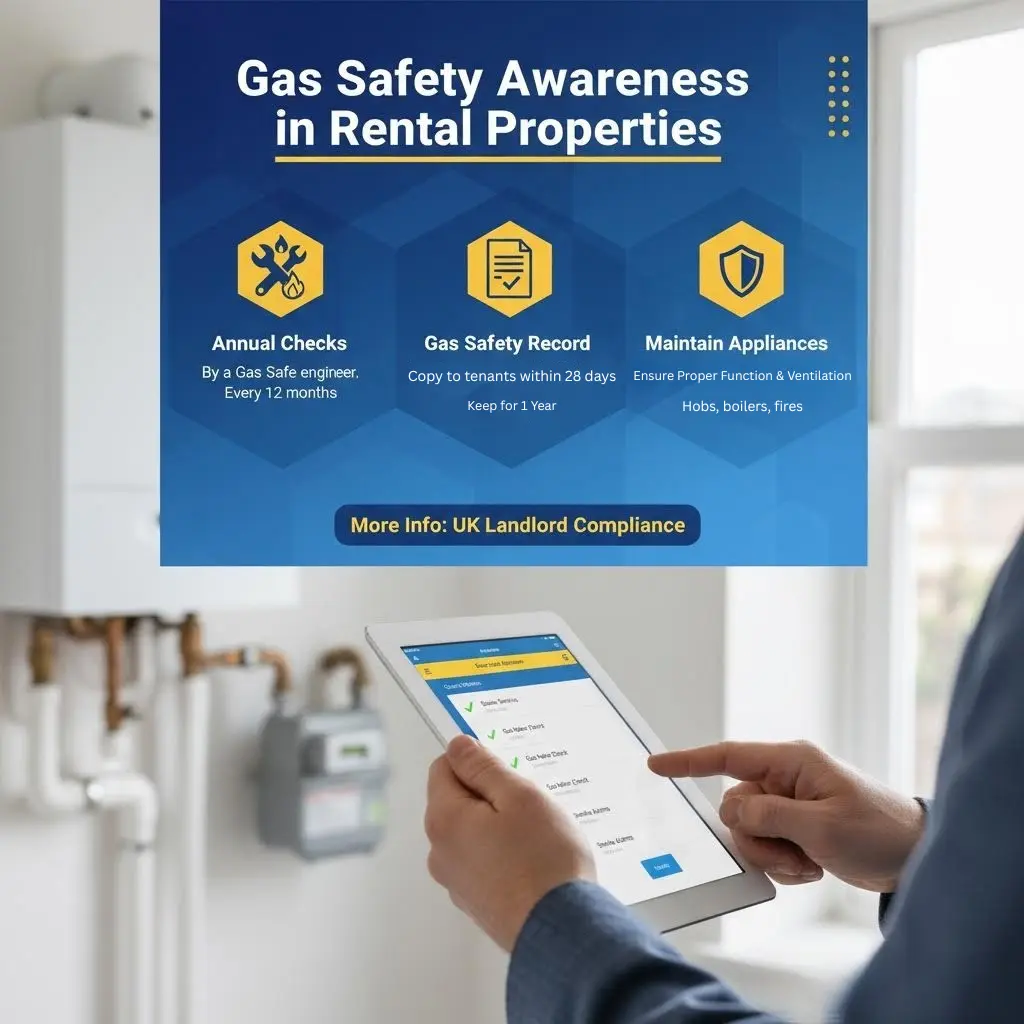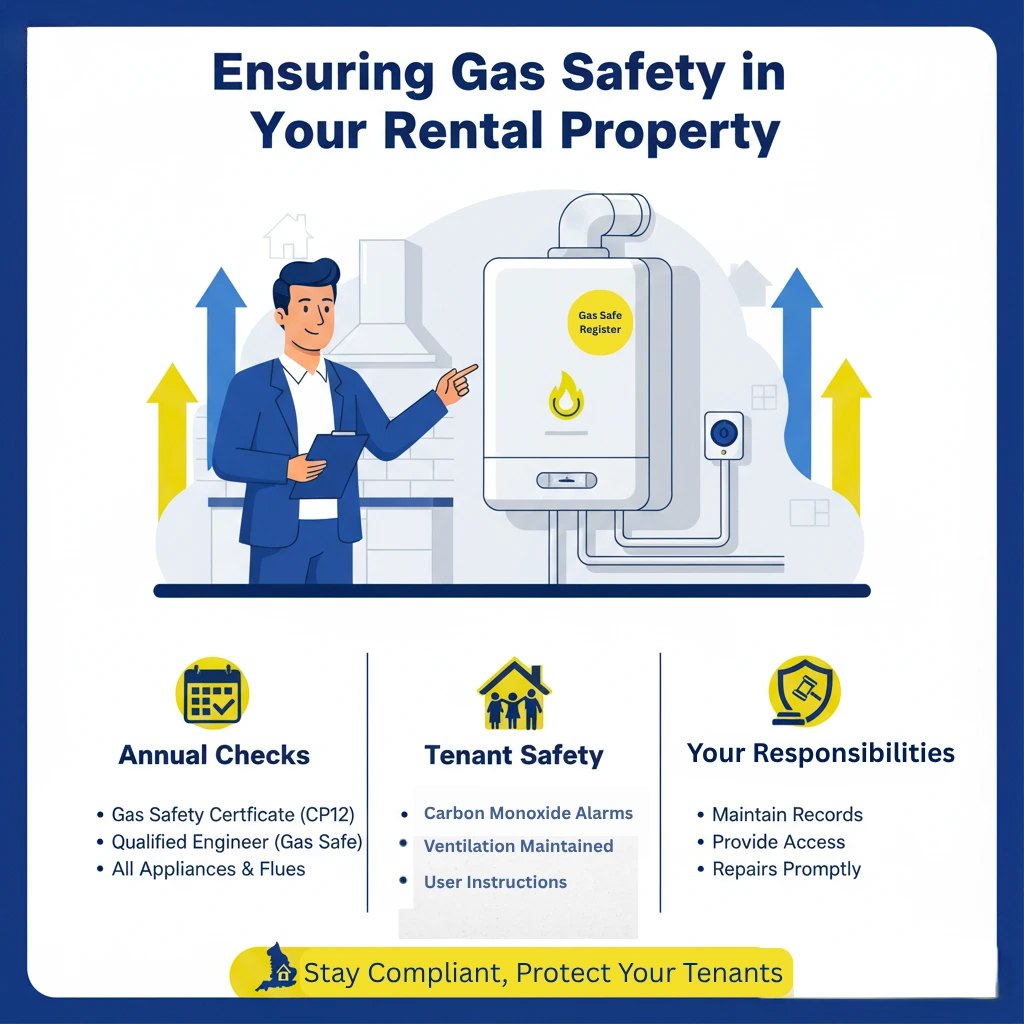Are you sure that the electrical system in your rental property is safe? Electrical problems cause about 14,000 house fires in the UK each year. These fires hurt many people and destroy a lot of property. Electrical faults can hide in sockets, wiring, or appliances, and they create real risks for tenants and landlords. That is why electrical testing for rental properties is so important. It keeps homes safe, meets legal rules, and helps landlords handle issues before they turn into big issues.
In this blog, you will learn everything about keeping electrical systems safe in rental properties. We cover inspections, certificates, and what to do when something goes wrong. You will get clear steps to protect your home and everyone in it.
What are the legal requirements for electrical checks on rented property?
If you have rental properties and rent them out, ensure that they are safe for your tenants. As a responsive person, you must follow all the rules about electrical safety for landlords. Electrical safety checks for landlords are not a paperwork or formality, it’s a legal duty.
Understanding the 5-year electrical test legal requirement

In the UK, every rented home must have an Electrical Installation Condition Report (EICR) done at least once every five years. This rule applies to all private landlords, including houses, flats, and HMOs (houses in multiple occupation).
Here’s what the 5-year check involves:
![]() A qualified electrician inspects the fixed electrical parts of the property, such as sockets, switches, light fittings, and the consumer unit.
A qualified electrician inspects the fixed electrical parts of the property, such as sockets, switches, light fittings, and the consumer unit.![]() The electrician looks for damage, wear, or potential risks.
The electrician looks for damage, wear, or potential risks.![]() A written EICR report is provided with the results and any recommendations for repair or improvement.
A written EICR report is provided with the results and any recommendations for repair or improvement.![]() If the report lists urgent issues (classified as C1 or C2), repairs must be done quickly within 28 days.
If the report lists urgent issues (classified as C1 or C2), repairs must be done quickly within 28 days.
This inspection is a vital part of electrical testing for rental properties. It helps to prove that landlords are aligned with safety responsibilities.
Electrical safety standards in the private rented sector (England) regulations 2020

The 2020 rules tell landlords what they have to do in England. They started on 1 June 2020 for new tenants, and on 1 April 2021 for people already renting. These rules come from the Housing Act 2004 and the Housing and Planning Act 2016. These apply to private rented tenancies in England. The rules are:
![]() Landlords must ensure that electrical safety standards are met during any period of a specified tenancy.
Landlords must ensure that electrical safety standards are met during any period of a specified tenancy.![]() The standard for electrical installations is BS 7671:2018 (the 18th Edition Wiring Regulations).
The standard for electrical installations is BS 7671:2018 (the 18th Edition Wiring Regulations).![]() Every fixed electrical installation must be inspected and tested by a qualified person at regular intervals, at least every 5 years, unless a shorter interval is recommended.
Every fixed electrical installation must be inspected and tested by a qualified person at regular intervals, at least every 5 years, unless a shorter interval is recommended.![]() Landlords must obtain a report, called an Electrical Installation Condition Report (EICR).
Landlords must obtain a report, called an Electrical Installation Condition Report (EICR).![]() The report must be supplied:
The report must be supplied:
![]() To a new tenant before occupation.
To a new tenant before occupation.![]() To an existing tenant within 28 days of the inspection/test.
To an existing tenant within 28 days of the inspection/test.![]() To a prospective tenant within 28 days of the request.
To a prospective tenant within 28 days of the request.![]() To the local housing authority within 7 days of a request.
To the local housing authority within 7 days of a request.![]() Any urgent remedial action identified (codes C1 or C2) must be carried out promptly to make the installation safe.
Any urgent remedial action identified (codes C1 or C2) must be carried out promptly to make the installation safe.![]() Landlords must retain the report until the next inspection is due.
Landlords must retain the report until the next inspection is due.![]() Landlords must use a competent, registered electrician approved by a recognized body such as NICEIC or NAPIT.
Landlords must use a competent, registered electrician approved by a recognized body such as NICEIC or NAPIT.![]() Regulations apply to new specified tenancies from 1 July 2020 and existing tenancies from 1 April 2021.
Regulations apply to new specified tenancies from 1 July 2020 and existing tenancies from 1 April 2021.
For more safety, UK authorities added new rules in 2025 after the 2020 rules. These rules make homes safer and include social housing so more people can live in good, safe homes. The law takes effect on 1 November 2025 for new tenancies and 1 May 2026 for older social tenancies. The new requirements include:
![]() Digital reporting: EICRs are stored and shared digitally, making it easier for councils and tenants to access records.
Digital reporting: EICRs are stored and shared digitally, making it easier for councils and tenants to access records.![]() Shorter repair deadlines: Urgent repairs completed within 21 days instead of 28, depending on risk level.
Shorter repair deadlines: Urgent repairs completed within 21 days instead of 28, depending on risk level.![]() Enhanced record-keeping: Landlords keep inspection and repair records for at least 10 years.
Enhanced record-keeping: Landlords keep inspection and repair records for at least 10 years.![]() Upgraded installation standards: All new installations follow the latest British Standard BS 7671:2018 (Amendment 2) and future updates.
Upgraded installation standards: All new installations follow the latest British Standard BS 7671:2018 (Amendment 2) and future updates.![]() Energy efficiency checks: Electrical inspections linked to energy performance, encouraging safer and more efficient systems.
Energy efficiency checks: Electrical inspections linked to energy performance, encouraging safer and more efficient systems.
Consequences of non-compliance with electrical testing regulations
Electrical regulations for landlords are built to protect tenants. If a landlord ignores the rules, the council can take action. This can include:
![]() Fines up to £30,000 per breach.
Fines up to £30,000 per breach.![]() Councils issue a formal notice to fix dangerous faults.
Councils issue a formal notice to fix dangerous faults.![]() If repairs are not done, the council carries out the work and charges the landlord.
If repairs are not done, the council carries out the work and charges the landlord.![]() Insurance claims get refused if accidents or damage happen.
Insurance claims get refused if accidents or damage happen.![]() Tenants take legal action for injuries caused by unsafe electrics.
Tenants take legal action for injuries caused by unsafe electrics.![]() Increased risk of electrical fires or shocks in the property.
Increased risk of electrical fires or shocks in the property.![]() Liability for injuries or death in extreme cases.
Liability for injuries or death in extreme cases.![]() Difficulty renting out the property until safety is proven.
Difficulty renting out the property until safety is proven.![]() Lower property value from repeated non-compliance records.
Lower property value from repeated non-compliance records.
What electrical certificates for rental properties do landlords need?
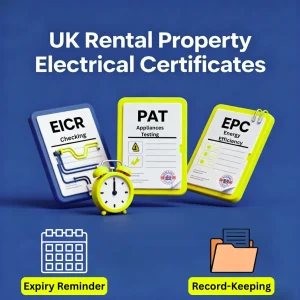
In the UK, landlords have clear rules to follow, so having the right certificates is key. If you rent out a property, keeping it safe is more than just fixing a dripping tap. Electrical testing in rented properties makes sure everything works properly and keeps tenants safe from shocks or fires.
Different types of electrical certification explained
There are a few certificates landlords need for electrical safety. These documents show that the property meets safety standards. These are:
![]() Electrical Installation Condition Report (EICR) – This certificate checks wiring, sockets, and the electrical system. It confirms everything works correctly and stays safe.
Electrical Installation Condition Report (EICR) – This certificate checks wiring, sockets, and the electrical system. It confirms everything works correctly and stays safe.![]() Portable Appliance Testing (PAT) – Any appliances provided in the property, like fridges, kettles, or heaters, receive this check.
Portable Appliance Testing (PAT) – Any appliances provided in the property, like fridges, kettles, or heaters, receive this check.![]() Energy Performance Certificate (EPC) – This certificate focuses on energy efficiency and covers electrical appliances, even though it doesn’t measure safety directly.
Energy Performance Certificate (EPC) – This certificate focuses on energy efficiency and covers electrical appliances, even though it doesn’t measure safety directly.
A landlord electrical safety certificate shows that a property’s electrical installations meet the required standards. Electrical safety regulations exist to protect tenants and ensure that privately rented homes are safe. These regulations require landlords to follow clear procedures and maintain safety in rental properties.
How long certificates remain valid
Each certificate lasts for a specific time. All landlords need to know how long they stay valid and when to renew them:
![]() EICR (Electrical Installation Condition Report) stays valid for 5 years.
EICR (Electrical Installation Condition Report) stays valid for 5 years.![]() PAT (Portable Appliance Testing) checks usually happen once every year.
PAT (Portable Appliance Testing) checks usually happen once every year.![]() EPC (Energy Performance Certificate) remains valid for 10 years
EPC (Energy Performance Certificate) remains valid for 10 years![]() Write the expiry dates on a visible calendar or reminder app.
Write the expiry dates on a visible calendar or reminder app.![]() Arrange new checks before the current ones expire.
Arrange new checks before the current ones expire.![]() Keep updated copies ready in case tenants or inspectors ask for them.
Keep updated copies ready in case tenants or inspectors ask for them.![]() Always store both paper and digital copies safely.
Always store both paper and digital copies safely.![]() Review dates every few months to stay on track.
Review dates every few months to stay on track.
Keeping certificates up to date keeps the property safe and follows UK rules for electrical safety.
Proper record-keeping for electrical safety documentation
Good records make life easier and show tenants that the property is safe:
![]() Keep digital copies on your computer or cloud.
Keep digital copies on your computer or cloud.![]() Keep paper copies in a safe folder.
Keep paper copies in a safe folder.![]() Write down the date of every inspection.
Write down the date of every inspection.![]() Note what the inspector finds or fixes.
Note what the inspector finds or fixes.![]() Give tenants copies if they ask.
Give tenants copies if they ask.![]() Keep a separate folder for each property if you have more than one.
Keep a separate folder for each property if you have more than one.![]() Review records regularly to make sure nothing is missing.
Review records regularly to make sure nothing is missing.
This system keeps landlords organized, makes inspections simple, and shows care for tenant safety. Electrical safety first is the principle that guides all inspections and maintenance. An electrical safety report records any faults or improvements needed. Electrical safety standards for private tenancies define the levels of care landlords must provide. Safety standards for private tenancies regulations make these obligations mandatory.
What does an EICR for rental properties involve?

An Electrical Installation Condition Report (EICR) checks the safety of a property’s electrical system. This inspection helps landlords keep tenants safe and follow UK rules. An EICR certificate confirms that all wiring, sockets, and circuits meet the required standards.
The process of Electrical Installation Condition Reports explained
Get Your Free EICR Compliance Checklist
Check Your Electrical Installations Today and Ensure Full Legal Compliance.
Download the Guide and Make Electrical Safety Simple and Easy.
An EICR inspection follows a clear, structured process:![]() Visual inspection: The electrician examines wiring, switches, sockets, and consumer units for signs of damage or deterioration.
Visual inspection: The electrician examines wiring, switches, sockets, and consumer units for signs of damage or deterioration.![]() Testing circuits: Each circuit undergoes electrical testing to confirm correct operation and safety.
Testing circuits: Each circuit undergoes electrical testing to confirm correct operation and safety.![]() Safety device check: RCDs (Residual Current Devices) and fuses are tested to ensure they work correctly.
Safety device check: RCDs (Residual Current Devices) and fuses are tested to ensure they work correctly.![]() Documentation: All observations, readings, and issues get recorded in a structured report.
Documentation: All observations, readings, and issues get recorded in a structured report.
These steps help landlords identify potential hazards before they pose a risk to tenants.
Common issues identified during an EICR inspection
When an electrician checks your property’s electrical system, they look for anything unsafe. Here, we talk about some common problems that electricians find:
![]() Loose or exposed wires: Wires not fixed properly or damaged create danger.
Loose or exposed wires: Wires not fixed properly or damaged create danger.![]() Broken sockets or switches: Damaged fittings stop working and create a shock risk.
Broken sockets or switches: Damaged fittings stop working and create a shock risk.![]() Missing earthing or bonding: Earthing and bonding protect from electric shocks.
Missing earthing or bonding: Earthing and bonding protect from electric shocks.![]() Faulty fuses or RCDs: Safety devices that do not work increase risk during faults.
Faulty fuses or RCDs: Safety devices that do not work increase risk during faults.![]() Overloaded circuits or poor installations: Too many appliances or bad wiring cause overheating or fire.
Overloaded circuits or poor installations: Too many appliances or bad wiring cause overheating or fire.![]() Signs of overheating: Burn marks or melted components indicate high risk.
Signs of overheating: Burn marks or melted components indicate high risk.![]() Old or worn-out wiring: Aging cables can fail or become unsafe.
Old or worn-out wiring: Aging cables can fail or become unsafe.![]() Unprotected cables in wet areas: Water and electricity together create serious hazards.
Unprotected cables in wet areas: Water and electricity together create serious hazards.![]() Improper or missing circuit labeling: Hard to know which circuit controls what, causing confusion during emergencies.
Improper or missing circuit labeling: Hard to know which circuit controls what, causing confusion during emergencies.
EICR certification and documentation requirements
After the inspection, the electrician prepares a detailed report. The report shows what they find and highlights any problems that cause danger. The report includes:
![]() Observations and test results for every part of the electrical system.
Observations and test results for every part of the electrical system.![]() Any urgent or recommended repairs.
Any urgent or recommended repairs.![]() Confirmation that the property meets current UK safety standards.
Confirmation that the property meets current UK safety standards.![]() Clear instructions for follow-up inspections or maintenance.
Clear instructions for follow-up inspections or maintenance.![]() Dates for the next required inspection.
Dates for the next required inspection.
As a responsible person or landlord, you need to keep this documentation. The documents show the property is safe and follows UK rules. It supports electrical testing for rented properties. It helps landlords prove the property meets safety standards. Keeping records and checking regularly keeps tenants safe.
How much does an electrical safety check for rental property cost?
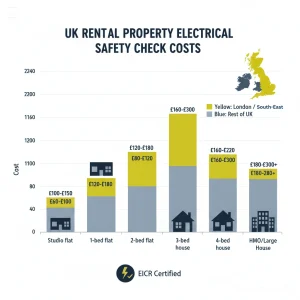
If you rent out a property, arranging an electrical safety check is important for safety and compliance. Many landlords ask about the cost, and it can vary depending on several factors.
Factors affecting electrical inspection pricing
The price of an electrical inspection depends on many things. Every landlord needs to know about that. Here is the list:
![]() Size of the property. Bigger homes have more wiring and take more time to check.
Size of the property. Bigger homes have more wiring and take more time to check.![]() Age of the wiring. Older systems may need extra attention.
Age of the wiring. Older systems may need extra attention.![]() Type of inspection. Full inspections take longer than simple checks.
Type of inspection. Full inspections take longer than simple checks.![]() Location. Prices change between towns and cities.
Location. Prices change between towns and cities.![]() Certification. Inspectors from different approved organizations charge differently.
Certification. Inspectors from different approved organizations charge differently.
Average costs for different property types
Here is a simple guide to what landlords pay for inspections in the UK:
![]() Studio or one-bedroom flat: £80 to £120
Studio or one-bedroom flat: £80 to £120![]() Two to three-bedroom house: £120 to £180
Two to three-bedroom house: £120 to £180![]() Four-bedroom or larger property: £180 to £250
Four-bedroom or larger property: £180 to £250![]() Large apartment blocks: prices start around £250 and go higher
Large apartment blocks: prices start around £250 and go higher
These numbers give a good idea of planning your budget for electrical safety checks. But every property can have a different price based on its wiring and size.
Cost comparison between NICEIC and other certified inspectors
Here is a clear comparison of prices for a rental property electrical inspection:
Inspector Type
Average Cost for 2-Bed Property
Notes
NICEIC Certified Like, Alllandlordcertificates.co.uk
£120 to £180
Recognized across the UK, a trusted certificate
Other Certified Inspectors
£100 to £170
Approved inspectors who meet legal standards
Inspector Type
Average Cost for 2-Bed Property
Notes
NICEIC Certified
Like, Alllandlord
certificates
.co.uk
£120 to £180
Recognized across the UK, a trusted certificate
Other Certified Inspectors
£100 to £170
Approved inspectors who meet legal standards
What are the specific HMO electrical requirements?
If you manage a House in Multiple Occupation (HMO), you need to make sure all electrical systems are safe and meet legal standards. HMO electrical requirements focus on protecting tenants and preventing accidents. Landlords must carry out electrical testing in rental properties to ensure everything works properly and safely.
Additional electrical safety standards for Houses in Multiple Occupation
HMO properties have extra responsibilities when it comes to electrical safety. Landlords must:
![]() Make sure all appliances are safe and checked regularly.
Make sure all appliances are safe and checked regularly.![]() Avoid overloading circuits in shared areas.
Avoid overloading circuits in shared areas.![]() Keep electrical certificates up to date and available for inspection.
Keep electrical certificates up to date and available for inspection.![]() Conduct Electrical testing for rental properties at least every five years or sooner if recommended by a qualified electrician.
Conduct Electrical testing for rental properties at least every five years or sooner if recommended by a qualified electrician.![]() Provide enough sockets for all tenants to prevent unsafe extensions.
Provide enough sockets for all tenants to prevent unsafe extensions.![]() Check that outdoor electrical points are weatherproof and safe.
Check that outdoor electrical points are weatherproof and safe.![]() Ensure tenants know how to report electrical faults quickly.
Ensure tenants know how to report electrical faults quickly.![]() Label fuse boards clearly for easy identification in emergencies.
Label fuse boards clearly for easy identification in emergencies.
It is important to know about landlord responsibilities to comply with the regulations. Landlords in England must give access to the property and provide a copy of the electrical safety certificate to tenants. Ensuring that the electrical installations work correctly is a key part of landlords’ duties.
Emergency lighting and fire safety electrical requirements
Fire safety is essential in HMO properties. Electrical systems play a big role in keeping tenants safe:
![]() Install emergency lighting in corridors, staircases, and escape routes.
Install emergency lighting in corridors, staircases, and escape routes.![]() Check fire alarms and smoke detectors regularly to ensure they work correctly.
Check fire alarms and smoke detectors regularly to ensure they work correctly.![]() Ensure all emergency circuits remain functional even during a power outage.
Ensure all emergency circuits remain functional even during a power outage.![]() Keep detailed records of inspections and maintenance to meet UK safety regulations.
Keep detailed records of inspections and maintenance to meet UK safety regulations.![]() Provide illuminated exit signs where needed.
Provide illuminated exit signs where needed.![]() Test backup lighting systems periodically to ensure they activate automatically.
Test backup lighting systems periodically to ensure they activate automatically.![]() Replace any faulty emergency lights immediately.
Replace any faulty emergency lights immediately.![]() Make tenants aware of emergency lighting locations and escape routes.
Make tenants aware of emergency lighting locations and escape routes.
How should landlords address faulty electrics in rented property?
Faulty electrics can be dangerous for tenants. Landlords need to act fast to keep the home safe. This includes safe wiring, working sockets, and good lighting. Landlords must do electrical testing rental properties with a qualified electrician. Regular checks help find problems early and keep tenants safe.
Timeframes for remedying electrical issues

Landlords fix electrical issues quickly. Some issues need urgent action, and others can be fixed soon after. Key points to follow:
![]() Dangerous faults, like exposed wires, get fixed immediately.
Dangerous faults, like exposed wires, get fixed immediately.![]() Small issues get repaired soon to stop them from getting worse.
Small issues get repaired soon to stop them from getting worse.![]() Keep tenants informed about repair schedules.
Keep tenants informed about repair schedules.![]() Plan repair visits clearly to avoid confusion.
Plan repair visits clearly to avoid confusion.![]() Check completed work to make sure it works properly.
Check completed work to make sure it works properly.![]() Arrange follow-up inspections to confirm safety.
Arrange follow-up inspections to confirm safety.![]() Avoid leaving any fault unresolved for more than a few days.
Avoid leaving any fault unresolved for more than a few days.
Landlord vs tenant responsibilities for electrical repairs
If a fault happens because of tenant misuse, the tenant pays for the repair. If the fault comes from normal wear or old wiring, the landlord arranges and pays for the fix. Landlords keep the electrical system in a rented property safe and working properly. This includes:
![]() Wiring is in good condition.
Wiring is in good condition.![]() The fuse box is working correctly.
The fuse box is working correctly.![]() Sockets and switches are functioning.
Sockets and switches are functioning.![]() Light fittings are safe to use.
Light fittings are safe to use.
Tenants take care of the property by:
![]() Using appliances safely.
Using appliances safely.![]() Avoiding overloading sockets.
Avoiding overloading sockets.![]() Reporting any faults or issues immediately.
Reporting any faults or issues immediately.
Regulations require landlords to meet all electrical safety obligations. Landlords must give their tenants the information they need to know about landlord electrical safety. Electrical safety standards regulations, and standards for private tenancies ensure every property meets the requirements for landlords.
Documentation of electrical fault remediation
Imagine a tenant calls about a faulty socket. Having clear records makes handling it much easier. Good documentation shows the landlord takes safety seriously and keeps everything organized. Every inspection, repair, and certificate should have a paper trail, including:
![]() Date of repair or test
Date of repair or test![]() Name of electrician or company
Name of electrician or company![]() Description of the fault and how it got fixed
Description of the fault and how it got fixed![]() Safety test results or certificates
Safety test results or certificates
It also helps to include results from electrical testing for rental properties. Keeping everything in order protects both landlord and tenant and proves the property meets UK electrical safety standards.
Is PAT testing in rented properties mandatory?
Many landlords and tenants ask us, PAT testing in rented properties is needed. The short answer is no, it is not a legal requirement in the UK for rented homes. But having a PAT testing certificate can give confidence that electrical appliances are safe.
The difference between PAT testing and EICR
Here is a simple comparison to help understand the difference between PAT testing and an Electrical Installation Condition Report (EICR):
Feature
PAT-Testing
EICR
What it checks
Individual portable appliances
Fixed electrical installations like sockets, wiring, and fuse boxes
Frequency
Recommended at regular intervals
Every 5 years for rented properties or as advised by an electrician
Purpose
Confirm appliance safety
Confirm the overall electrical safety of a property
Who can do it
Qualified PAT tester or electrician
Qualified electrician with EICR certification
Certificate
PAT testing certificate
EICR report
Feature
PAT Testing
EICR
What it checks
Individual portable appliances
Fixed electrical installations like sockets, wiring, and fuse boxes
Frequency
Recommended at regular intervals
Every 5 years for rented properties or as advised by an electrician
Purpose
Confirm appliance safety
Confirm the overall electrical safety of a property
Who can do it
Qualified PAT tester or electrician
Qualified electrician with EICR certification
Certificate
PAT testing certificate
EICR report
Legal requirements for testing portable appliances
In the UK, landlords have legal responsibilities for electrical safety. Some key points for portable appliances include:
![]() All supplied appliances must be safe to use.
All supplied appliances must be safe to use.![]() Regular inspections reduce the risk of electric shock or fire.
Regular inspections reduce the risk of electric shock or fire.![]() Keeping records of tests is recommended for legal compliance.
Keeping records of tests is recommended for legal compliance.![]() PAT testing helps landlords follow safety rules and show tenants that appliances are safe.
PAT testing helps landlords follow safety rules and show tenants that appliances are safe.
New electrical safety measures apply to properties, including property and electrical systems in privately rented homes. Landlords must have the electrical installation checked regularly. Mandatory electrical safety checks confirm that electrical appliances like heaters, kettles, or washing machines are safe to use.
Case Study: Norwich Landlord Fined for Missing Electrical Certificate
A landlord in Norwich rented out a house with serious electrical problems and did not have a safety certificate. The council found faults in the wiring, and no record of any inspection.
The landlord faced a fine of £5,500, had to pay £4,600 in costs, and a small victim surcharge. Officials said that if a fire had happened, the landlord could have faced much harsher consequences.
This shows that skipping electrical checks on rented property puts tenants at risk and can lead to big legal and financial issues for landlords.
Wrap up
Now it’s wrap-up time. Now you know how important electrical testing for rental properties is. Regular checks catch issues early, keep your tenants safe, and protect your property from damage.
At Alllandlordcertificates.co.uk, we make getting an electrical safety certificate quick and easy. You get clear results, peace of mind, and a safer home for everyone.
Take the step today to check your electrics and keep your property safe and sound.

